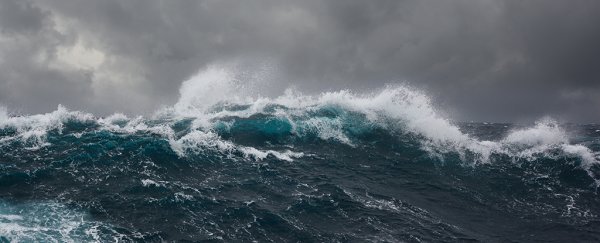Nature can be by turns both awe-inspiring and terrifying, and we're going to place this somewhere in the middle of the two. A monster wave reaching a height of 23.8 metres (78.1 feet) just set a new height record for the southern hemisphere.
The huge wave was recorded by a buoy in the Southern Ocean near Campbell Island, around 700 kilometres (435 miles) south of New Zealand. An intensely ferocious storm helped the waves to get up to record-breaking heights.
The new 23.8-metre watermark is more than a metre and a half over the previous record, 22.03 metres (72.3 feet), set in 2012 off the coast of Tasmania.
 Data collected as the storm passed. (MetOcean Solutions)
Data collected as the storm passed. (MetOcean Solutions)
"To our knowledge it is largest wave ever recorded in the southern hemisphere," says senior oceanographer Tom Durrant from MetOcean Solutions, which measured the wave. "Indeed, surfers in California can expect energy from this storm to arrive at their shores in about a week's time."
The researchers think the storm's waves may have exceed the 25 metre (82 feet) mark, but without being recorded by their instruments. The buoy in question is powered by solar energy and only records for 20 minutes every 3 hours to save battery power.
"During that 20 minute recording period, the height, period and direction of every wave is measured and statistics are calculated," says Durrant. "It's very probable that larger waves occurred while the buoy was not recording."
So how tall are we talking? 23.8 metres is about the height of an eight-storey building, or five-and-a-half London double-decker buses. It would've splashed up over the roof of the White House in Washington DC.
Imagine swaying on a boat in those conditions and dropping that sort of height in just a few seconds.
The researchers say a low-pressure cell was travelling over the water at the same speed as the waves it was forcing, meaning those waves could grow and grow as they stayed under the influence of the storm.
And the importance of the wave goes well beyond record-breaking feats. This part of the ocean is the "engine room" for creating swell waves that spread out across the rest of the planet, affecting wave and weather conditions in neighbouring areas.
The storm also registered a "significant wave height" of 14.9 metres (48.9 feet) – that's the World Meteorological Organisation (WMO) standard for measuring the volatility of the ocean, and means the average height of the highest third of measured waves.
While that's a record for the South Ocean, it pales in comparison to the world record – the highest significant wave height ever recorded was logged in the North Atlantic in 2013, at 19 metres (62.3 feet).
All of these records may start to tumble in the near future, though. One of the consequences of a warming world is thought to be more intense storms – and that means larger waves.
"This is exactly the sort of data we were hoping to capture at the outset of the program," says the man in charge of deploying the buoy back in March, Peter McComb from MetOcean Solutions.
"We know that the speed of these storms plays an important role in the resultant wave climate and that has great relevance under both the existing and climate change scenarios."
The data being measured by these buoys is open to the scientific community and can be found online at the MetOcean Solutions website.
And the biggest wave ever recorded? According to Smithsonian, tsunami wave from 1958 that hit Alaska's Lituya Bay was recorded at 100 feet (30.5m). No thanks.
